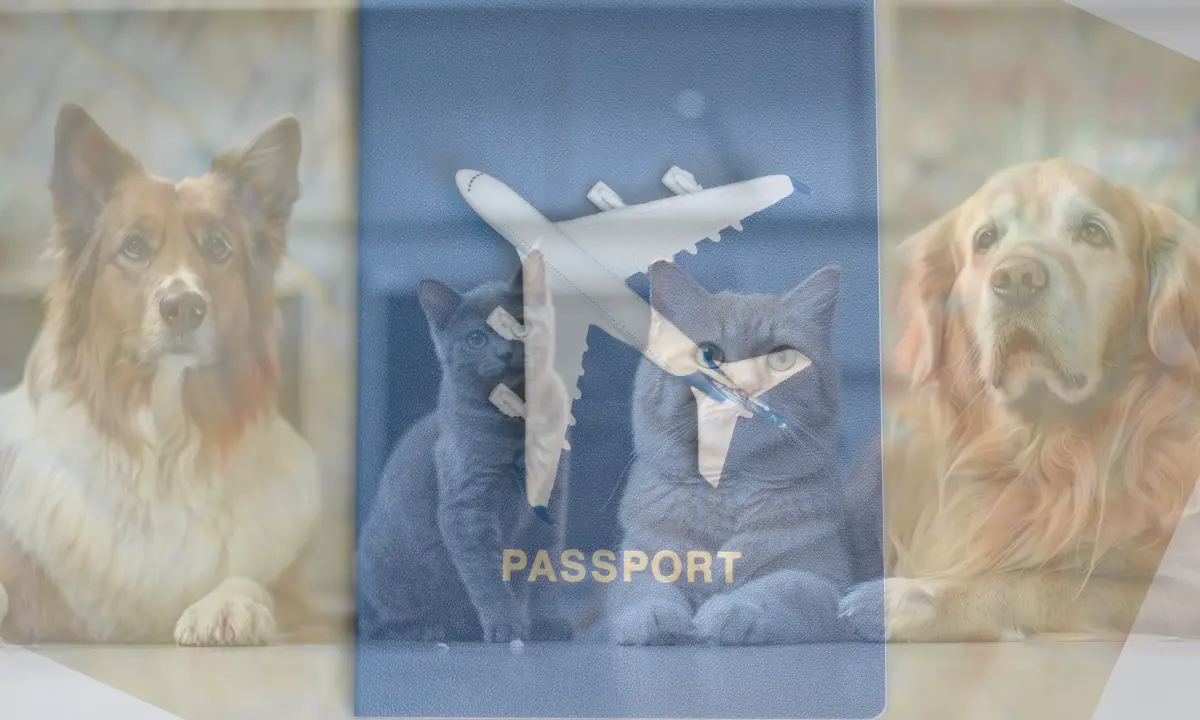Have you heard about a pet passport when researching international pet travel? There seems to be some confusion around the subject.
In Australia, we don’t use pet passports. Your dog doesn’t need a passport to travel – although that’d be pretty cool to have.
Some regions do use pet passports, though. Maybe this is where the confusion comes from.
The European Union has a pet passport. This regulates the travel to another EU country (in this case the 27 EU countries + Norway and the UK) with your dog, cat or ferret.
The European pet passport does not apply to cats and dogs being imported or returning to Australia.
Pets travelling to Australia need an import permit and other documentation.
Collectively, you could consider this as a pet passport. But Australia doesn’t have a single document known as a pet passport – like how we have a passport.
Let’s cover the documentation on an EU pet passport and compare it to the documentation usually needed for pets entering Australia.
What is a Pet Passport?
A pet passport is a document designed to facilitate the international travel of pets. The pet passport as an official document is mainly confined to the European Union.
Beth Schutte, a board member of the International Pet and Animal Transport Association (IPATA), states:
“The European Union primarily pioneered this whole pet passport practice that enables animals to move more freely with their owners throughout the European Union…”
The EU Pet Passport Scheme allows you to travel freely between EU countries with your pet. This means your pet won’t need to quarantine in these countries upon arrival.
The pet passport is a comprehensive record of essential information about your pet. It enables authorities to verify their identity, health status, and vaccination history across EU countries.
Essentially, EU pet passports are detailed vaccination and health records of pets. They are unique because each page has the document number at the bottom of the page.
Contents of a Typical Pet Passport
The EU Pet Passport contains a description of your pet and other details. These details include:
- Microchip or tattoo code
- Rabies vaccination record
- General vaccination records
- Rabies titre test results (if needed)
- Parasite treatment records
- Details of the issuing vet
- Owner contact details
- Health check pages
Any authorised vet (permitted by the relevant authorities to issue pet passports) can issue an EU Pet Passport to dogs, cats and ferrets.
The pet passport is valid for life as long as your pet’s rabies vaccination is up to date and a registered vet has completed a health check within 10 days of the travel date.
Let’s compare this to the documentation you need to import pets into Australia.
Documentation for Importing Pets to Australia
When importing pets into Australia, a comprehensive set of documents is required to comply with biosecurity measures. These documents must be accurate, up-to-date, and readily available.
Essential documents for pet travel
- Import Permit: Issued by the Australian Department of Agriculture, Fisheries and Forestry to confirm your pet’s eligibility to enter the country.
- Vaccination Records: Detailed documentation of all vaccinations, including rabies, from an approved vet.
- Rabies Titre Test: An official certificate from an approved laboratory showing a satisfactory test result.
- Health Certificate: A certificate issued by an approved vet within a specified time before travel, stating that the pet is free of infectious diseases and fit for travel.
- Treatment Records: Records of treatments for internal and external parasites signed off by an approved vet.
- Microchip Certification: Proof that the pet has been microchipped with an ISO-compliant chip.
- Flight Details: Information about the flight and a booking confirmation for the pet’s travel.
We can help you navigate the essential travel documents for bringing your pet to Australia.
Applying for an EU Pet Passport
An EU Pet Passport is essential for travelling between EU countries. Authorised EU vets issue pet passports.
Those travelling to the EU or Northern Ireland can also bring their pets with a pet passport issued by an authorised vet in the following countries:
- Andorra
- Switzerland
- Faroe Islands
- Gibraltar
- Greenland
- Iceland
- Liechtenstein
- Monaco
- Norway
- San Marino
- Vatican City State
Take your pet to an authorised vet and fill out the required information. This includes your details, your pet’s identifying information and vaccination records.
Once you get a pet passport, it’s valid for life – on one condition. You must keep up to date with your pet’s rabies vaccination.
If the rabies vaccine lapses, you need to revaccinate your pet and retest for rabies if required by the destination country. A registered vet will record this information on the pet passport.
Benefits of Having a Pet Passport
Let’s say you’re relocating from Australia to a European Union country. What would be the benefits of having a pet passport?
Hassle-free travel within the EU
- A pet passport is that it makes travel with your pets within the EU hassle-free.
- You can navigate customs procedures more efficiently, reducing the likelihood of complications during travel.
- You don’t need to apply for an entry permit for each country you visit.
Proof of pet’s identity and vaccination history
- A pet passport serves as a comprehensive record of a pet’s identity and vaccination history.
- Provides authorities with essential information to verify the pet’s identity and ensure compliance with vaccination requirements.
- This information streamlines the entry process into countries and provides peace of mind for you as a pet owner.
Prevents quarantine in destination countries
- A valid pet passport can help prevent quarantine requirements and entry issues for pets.
- Pet passports demonstrate that your pet meets the necessary health and safety standards required for entry into EU countries.
- Helps avoid lengthy quarantine periods and ensures your pet can accompany you during travel.
Where Can Pets Travel With an EU Passport?
You can travel with your pet between all EU and EEA countries with a valid EU Pet Passport. Your pet won’t need to undergo quarantine.
The EU countries are:
- Austria
- Belgium
- Bulgaria
- Croatia
- Cyprus
- Czech Republic
- Denmark
- Estonia
- Finland
- France
- Germany
- Greece
- Hungary
- Ireland
- Northern Ireland
- Italy
- Latvia
- Lithuania
- Luxembourg
- Malta
- Netherlands
- Poland
- Portugal
- Romania
- Slovakia
- Slovenia
- Spain
- Sweden
EEA (European Economic Area) countries are Iceland, Liechtenstein and Norway.
Some non-EU countries also accept the EU Pet Passport.
- Andorra
- Switzerland
- Faroe Islands
- Gibraltar
- Greenland
- Monaco
- San Marino
- Vatican City State
Conclusion
Pet passports are primarily a European Union phenomenon. We don’t use a standardised pet passport here in Australia.
But the documentation you need to travel to Australia with your pet is similar to the documentation needed for a pet passport.
In that sense, you may think of the required entry paperwork as a pet passport.
You need the following to bring your pets to Australia:
- Import Permit
- Vaccination Records
- Rabies Titre Test
- Health Certificate
- Treatment Records
- Microchip Certification
- Flight Details
Travelling with pets to Australia can seem hard to navigate. We’re here to answer any questions and help you on your journey.





Share this article